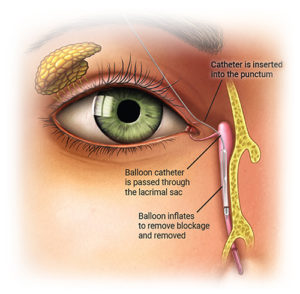
Patient Care
Blocked Tear Duct
As many as 20 percent of newborn babies have a blocked tear duct at birth, but it usually clears up on its own in the first year of life. Adults can get a blocked tear duct as a result of an infection, inflammation, an injury or a tumor. A blocked tear duct almost always is correctable, but the treatment depends on the cause and your age.
Tears normally drain from the eye through small tubes called tear ducts that extend from the eye into the nose. A blocked tear duct occurs when the duct that normally allows tears to drain from the eyes is obstructed or fails to open properly, this causes the signs and symptoms listed below.
Signs and Symptoms may be:
• Excessive tearing or watery eyes
• Recurrent eye inflammation (conjunctivitis) or recurrent eye infections (dacryocystitis)
• Painful swelling of the inside corner of the eye
• Eye mucus discharge
• Blurred vision
• Bloody tears

Choose the Best Treatment Option
One treatment for this condition includes probing of the lacrimal system in children. The problem with probing is that the effect may be temporary. However, the LacriCATH technology is used in a similar manner as ordinary probing with the added benefit of an expandable balloon, which opens the blocked tear duct effectively. This balloon technology means patients can achieve highly effective results while reducing the trauma they experience.
Another treatment is endoscopic or incisional dacryocystorhinosotomy (DCR) surgery for adults, and as needed for children. The DCR catheter provides more options to patients who have been told only an incisional DCR surgery will solve their chronic tearing problem. Many times incisional DCRs result in scarring that can make wearing glasses uncomfortable. Doctors using the LacriCATH balloon catheter have found it is easy to use and provides a cost effective way to treat epiphora (chronic tearing) in both pediatric and adult patients.
LacriCATH Advantages with DCP Procedure
• Reduces trauma
• No tubes to remove – or pull out
• No need for a second procedure with anesthesia for tube removal

Patient Resources
Pediatric Brochure: LacriCATH DCP Procedure Overview
Adult Brochure: LacriCATH DCR Procedure Overview


